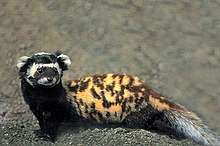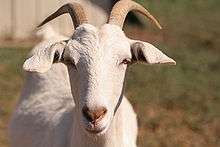List of mammals of Syria
This is a list of the mammal species recorded in Syria. There are seventy-one mammal species in Syria, of which one is critically endangered, three are endangered, six are vulnerable, and three are near threatened. One of the species listed for Syria can no longer be found in the wild.[1]
The following tags are used to highlight each species' conservation status as assessed by the International Union for Conservation of Nature:
| EX | Extinct | No reasonable doubt that the last individual has died. |
| EW | Extinct in the wild | Known only to survive in captivity or as a naturalized populations well outside its previous range. |
| CR | Critically endangered | The species is in imminent risk of extinction in the wild. |
| EN | Endangered | The species is facing an extremely high risk of extinction in the wild. |
| VU | Vulnerable | The species is facing a high risk of extinction in the wild. |
| NT | Near threatened | The species does not meet any of the criteria that would categorise it as risking extinction but it is likely to do so in the future. |
| LC | Least concern | There are no current identifiable risks to the species. |
| DD | Data deficient | There is inadequate information to make an assessment of the risks to this species. |
Some species were assessed using an earlier set of criteria. Species assessed using this system have the following instead of near threatened and least concern categories:
| LR/cd | Lower risk/conservation dependent | Species which were the focus of conservation programmes and may have moved into a higher risk category if that programme was discontinued. |
| LR/nt | Lower risk/near threatened | Species which are close to being classified as vulnerable but are not the subject of conservation programmes. |
| LR/lc | Lower risk/least concern | Species for which there are no identifiable risks. |
Subclass: Theria
Infraclass: Eutheria
Order: Proboscidea (elephants)
The elephants comprise three living species and are the largest living land animals.
- Family: Elephantidae (elephants)
- Genus: Elephas
- Species: Asian elephant, Elephas maximus EN
- Syrian elephant, Elephas maximus asurus EX
- Species: Asian elephant, Elephas maximus EN
- Genus: Elephas
Order: Hyracoidea (hyraxes)

The hyraxes are any of four species of fairly small, thickset, herbivorous mammals in the order Hyracoidea. About the size of a domestic cat they are well-furred, with rounded bodies and a stumpy tail. They are native to Africa and the Middle East.
- Family: Procaviidae (hyraxes)
- Genus: Procavia
- Cape hyrax, Procavia capensis LC
- Genus: Procavia
Order: Rodentia (rodents)
Rodents make up the largest order of mammals, with over 40% of mammalian species. They have two incisors in the upper and lower jaw which grow continually and must be kept short by gnawing. Most rodents are small though the capybara can weigh up to 45 kg (99 lb).
- Suborder: Sciurognathi
- Family: Sciuridae (squirrels)
- Subfamily: Sciurinae
- Tribe: Sciurini
- Genus: Sciurus
- Caucasian squirrel, Sciurus anomalus LR/nt
- Genus: Sciurus
- Tribe: Sciurini
- Subfamily: Xerinae
- Tribe: Marmotini
- Genus: Spermophilus
- Asia Minor ground squirrel, Spermophilus xanthoprymnus LR/lc
- Genus: Spermophilus
- Tribe: Marmotini
- Subfamily: Sciurinae
- Family: Gliridae (dormice)
- Subfamily: Leithiinae
- Genus: Dryomys
- Forest dormouse, Dryomys nitedula LR/nt
- Genus: Eliomys
- Asian garden dormouse, Eliomys melanurus LC
- Genus: Dryomys
- Subfamily: Leithiinae
- Family: Dipodidae (jerboas)
- Subfamily: Allactaginae
- Genus: Allactaga
- Euphrates jerboa, Allactaga euphratica LR/nt
- Genus: Allactaga
- Subfamily: Allactaginae
- Family: Spalacidae
- Subfamily: Spalacinae
- Genus: Nannospalax
- Palestine mole rat, Nannospalax ehrenbergi LC
- Genus: Nannospalax
- Subfamily: Spalacinae
- Family: Calomyscidae
- Genus: Calomyscus
- Tsolov's mouse-like hamster, Calomyscus tsolovi LR/nt
- Genus: Calomyscus
- Family: Cricetidae
- Subfamily: Cricetinae
- Genus: Mesocricetus
- Golden hamster, Mesocricetus auratus EN
- Turkish hamster, Mesocricetus brandti LR/lc
- Genus: Mesocricetus
- Subfamily: Arvicolinae
- Genus: Chionomys
- Snow vole, Chionomys nivalis LR/nt
- Genus: Microtus
- Günther's vole, Microtus guentheri LR/nt
- Persian vole, Microtus irani LR/lc
- Social vole, Microtus socialis LR/lc
- Genus: Chionomys
- Subfamily: Cricetinae
- Family: Muridae (mice, rats, voles, gerbils, hamsters, etc.)
- Subfamily: Deomyinae
- Genus: Acomys
- Cairo spiny mouse, Acomys cahirinus LC
- Genus: Acomys
- Subfamily: Gerbillinae
- Genus: Gerbillus
- Wagner's gerbil, Gerbillus dasyurus LR/lc
- Genus: Meriones
- Sundevall's jird, Meriones crassus LC
- Libyan jird, Meriones libycus LC
- Tristram's jird, Meriones tristrami LR/lc
- Vinogradov's jird, Meriones vinogradovi LR/lc
- Genus: Psammomys
- Sand rat, Psammomys obesus LC
- Genus: Tatera
- Indian gerbil, Tatera indica LR/lc
- Genus: Gerbillus
- Subfamily: Murinae
- Genus: Apodemus
- Yellow-necked mouse, Apodemus flavicollis LR/lc
- Genus: Mus
- Macedonian mouse, Mus macedonicus LR/lc
- Genus: Nesokia
- Short-tailed bandicoot rat, Nesokia indica LC
- Genus: Apodemus
- Subfamily: Deomyinae
- Family: Sciuridae (squirrels)
Order: Lagomorpha (lagomorphs)
The lagomorphs comprise two families, Leporidae (hares and rabbits), and Ochotonidae (pikas). Though they can resemble rodents, and were classified as a superfamily in that order until the early 20th century, they have since been considered a separate order. They differ from rodents in a number of physical characteristics, such as having four incisors in the upper jaw rather than two.
- Family: Leporidae (rabbits, hares)
- Genus: Lepus
- Cape hare, Lepus capensis LR/lc
- European hare, Lepus europaeus LR/lc
- Genus: Lepus
Order: Erinaceomorpha (hedgehogs and gymnures)
The order Erinaceomorpha contains a single family, Erinaceidae, which comprise the hedgehogs and gymnures. The hedgehogs are easily recognised by their spines while gymnures look more like large rats.
- Family: Erinaceidae (hedgehogs)
- Subfamily: Erinaceinae
- Genus: Erinaceus
- Southern white-breasted hedgehog, Erinaceus concolor LR/lc
- Genus: Hemiechinus
- Desert hedgehog, Hemiechinus aethiopicus LR/lc
- Long-eared hedgehog, Hemiechinus auritus LR/lc
- Genus: Erinaceus
- Subfamily: Erinaceinae
Order: Soricomorpha (shrews, moles, and solenodons)
The "shrew-forms" are insectivorous mammals. The shrews and solenodons closely resemble mice while the moles are stout-bodied burrowers.
- Family: Soricidae (shrews)
- Subfamily: Crocidurinae
- Genus: Crocidura
- Lesser white-toothed shrew, Crocidura suaveolens LR/lc
- Genus: Crocidura
- Subfamily: Crocidurinae
Order: Chiroptera (bats)
The bats' most distinguishing feature is that their forelimbs are developed as wings, making them the only mammals capable of flight. Bat species account for about 20% of all mammals.
- Family: Pteropodidae (flying foxes, Old World fruit bats)
- Subfamily: Pteropodinae
- Genus: Rousettus
- Egyptian fruit bat, Rousettus aegyptiacus LC
- Genus: Rousettus
- Subfamily: Pteropodinae
- Family: Vespertilionidae
- Subfamily: Myotinae
- Genus: Myotis
- Lesser mouse-eared bat, Myotis blythii LR/lc
- Greater mouse-eared bat, Myotis myotis LR/nt
- Genus: Myotis
- Subfamily: Vespertilioninae
- Genus: Eptesicus
- Botta's serotine, Eptesicus bottae LC
- Genus: Otonycteris
- Desert long-eared bat, Otonycteris hemprichii LR/lc
- Genus: Pipistrellus
- Kuhl's pipistrelle, Pipistrellus kuhlii LC
- Genus: Plecotus
- Grey long-eared bat, Plecotus austriacus LR/lc
- Genus: Eptesicus
- Subfamily: Miniopterinae
- Genus: Miniopterus
- Schreibers' long-fingered bat, Miniopterus schreibersii LC
- Genus: Miniopterus
- Subfamily: Myotinae
- Family: Nycteridae
- Genus: Nycteris
- Egyptian slit-faced bat, Nycteris thebaica LC
- Genus: Nycteris
- Family: Rhinolophidae
- Subfamily: Rhinolophinae
- Genus: Rhinolophus
- Blasius's horseshoe bat, Rhinolophus blasii NT
- Mediterranean horseshoe bat, Rhinolophus euryale VU
- Greater horseshoe bat, Rhinolophus ferrumequinum LR/nt
- Genus: Rhinolophus
- Subfamily: Rhinolophinae
Order: Cetacea (whales)
The order Cetacea includes whales, dolphins and porpoises. They are the mammals most fully adapted to aquatic life with a spindle-shaped nearly hairless body, protected by a thick layer of blubber, and forelimbs and tail modified to provide propulsion underwater.
Species listed below also includes species being recorded in Levantine Sea.
- Suborder: Mysticeti
- Family: Balaenopteridae
- Genus: Balaenoptera
- Blue whale, Balaenoptera musculus EN (possible)[2]
- Fin whale, Balaenoptera physalus EN
- Common minke whale, Balaenoptera acutorostrata LC [3]
- Genus: Balaenoptera
- Family: Balaenopteridae
- Subfamily: Megapterinae
- Genus: Megaptera
- Humpback whale, Megaptera novaeangliae LC[4]
- Family: Eschrichtiidae
- Genus: Eschrichtius
- North Atlantic gray whale, Eschrichtius robustus EX (possibly a vagrant from Pacific was recorded off Israel in 2010[5])
- Genus: Eschrichtius
- Family: Balaenidae
- Genus: Eubalaena
- North Atlantic right whale, Eubalaena glacialis CR (possible)[6]
- Genus: Eubalaena
- Genus: Megaptera
- Suborder: Odontoceti
- Family: Physeteridae
- Genus: Physeter
- Sperm whale, Physeter macrocephalus VU
- Genus: Physeter
- Family: Ziphidae
- Genus: Ziphius
- Cuvier's beaked whale, Ziphius cavirostris LC
- Genus: Mesoplodon
- Gervais' beaked whale, Ziphius cavirostris DD
- Genus: Ziphius
- Superfamily: Platanistoidea
- Family: Delphinidae (marine dolphins)
- Genus: Tursiops
- Common bottlenose dolphin, Tursiops truncatus LC
- Genus: Steno
- Rough-toothed dolphin, Steno bredanensis DD (once being considered as vagrants, but later confirmed as residential[7])
- Genus: Stenella
- Striped dolphin, Stenella coeruleoalba DD
- Pantropical spotted dolphin, Stenella attenuata LR/cd (possible)[3]
- Genus: Sousa
- Sousa chinensis DD
- Genus: Delphinus
- Short-beaked common dolphin, Delphinus delphis LC
- Genus: Grampus
- Risso's dolphin, Grampus griseus LC
- Genus: Orcinus
- Orca, Orcinus orca DD
- Genus: Pseudorca
- False killer whale, Pseudorca crassidens DD
- Genus: Globicephala
- Long-finned pilot whale, Globicephala melas DD
- Genus: Tursiops
- Family: Delphinidae (marine dolphins)
- Family: Physeteridae
Order: Carnivora (carnivorans)
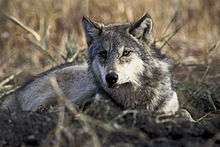
There are over 260 species of carnivorans, the majority of which feed primarily on meat. They have a characteristic skull shape and dentition.
- Suborder: Feliformia
- Family: Felidae (cats)
- Family: Herpestidae (mongooses)
- Genus: Herpestes
- Egyptian mongoose, H. ichneumon[8] LC
- Genus: Herpestes
- Family: Hyaenidae (hyaenas)
- Genus: Hyaena
- Striped hyena, H. hyaena[8] NT
- Genus: Hyaena
- Suborder: Caniformia
- Family: Canidae (dogs, foxes)
- Genus: Vulpes
- Red fox, V. vulpes[8] LC
- Rüppell's fox, V. rueppellii[8] LC
- Genus: Canis
- Golden jackal, C. aureus[8] LC
- Grey wolf, C. lupus[8] LC
- Genus: Vulpes
- Family: Ursidae (bears)
- Genus: Ursus
- Syrian brown bear, Ursus arctos syriacus EX[8]
- Genus: Ursus
- Family: Mustelidae (mustelids)
- Genus: Mustela
- Least weasel, M. nivalis[8] LC
- Genus: Vormela
- Marbled polecat, V. peregusna[8] LC
- Genus: Meles
- Eurasian badger, M. meles[8] LC
- Genus: Lutra
- European otter, L. lutra[8] NT
- Genus: Mustela
- Family: Phocidae (earless seals)
- Genus: Monachus
- Mediterranean monk seal, Monachus monachus CR
- Genus: Monachus
- Family: Canidae (dogs, foxes)
Order: Perissodactyla (odd-toed ungulates)
The odd-toed ungulates are browsing and grazing mammals. They are usually large to very large, and have relatively simple stomachs and a large middle toe.
- Family: Equidae (horses etc.)
- Genus: Equus
- Syrian wild ass, Equus hemionus hemippus EX
- Genus: Equus
Order: Artiodactyla (even-toed ungulates)
The even-toed ungulates are ungulates whose weight is borne about equally by the third and fourth toes, rather than mostly or entirely by the third as in perissodactyls. There are about 220 artiodactyl species, including many that are of great economic importance to humans.
- Family: Cervidae (deer)
- Subfamily: Capreolinae
- Family: Bovidae (cattle, antelope, sheep, goats)
- Subfamily: Antilopinae
- Genus: Gazella
- Mountain gazelle, Gazella gazella VU
- Saudi gazelle, Gazella saudiya EW
- Goitered gazelle, Gazella subgutturosa VU
- Genus: Gazella
- Subfamily: Caprinae
- Genus: Capra
- Wild goat, Capra aegagrus VU
- Nubian ibex, Capra nubiana EN
- Genus: Capra
- Subfamily: Hippotraginae
- Genus: Oryx
- Arabian oryx, Oryx leucoryx EN
- Genus: Oryx
- Subfamily: Antilopinae
See also
Notes
- This list is derived from the IUCN Red List which lists species of mammals and includes those mammals that have recently been classified as extinct (since 1500 AD). The taxonomy and naming of the individual species is based on those used in existing Wikipedia articles as of 21 May 2007 and supplemented by the common names and taxonomy from the IUCN, Smithsonian Institution, or University of Michigan where no Wikipedia article was available.
- Frantzis A., Alexiadou P., Paximadis G., Politi E., Gannier A., Corsini-Foka M. (2003). "Current knowledge of the cetacean fauna of the Greek Seas" (PDF). Journal of Cetacean Research and Management. International Whaling Commission. 5 (3): 219–232. Retrieved 2016-04-16.CS1 maint: uses authors parameter (link)
- Update on the Cetacean Fauna of the Mediterranean Levantine Basin
- Are humpback whales electing the Mediterranean Sea as new residence?
- "Are grey whales climate change's big winners?".
- Monsarrat S., Pennino G. M., Smith D. T., Reeves R.R., Meynard N. C., Kaplan M. D., Rodrigues L. S. A. (2015). "Historical summer distribution of the endangered North Atlantic right whale (Eubalaena glacialis): a hypothesis based on environmental preferences of a congeneric species" (PDF). Diversity and Distributions. 21 (8): 925–937. doi:10.1111/ddi.12314. Retrieved 2016-04-20.CS1 maint: uses authors parameter (link)
- "Archived copy" (PDF). Archived from the original (PDF) on 2016-05-13. Retrieved 2016-04-19.CS1 maint: archived copy as title (link)
- Masseti, M. (2009). "Carnivores of Syria". In Neubert, E.; Amr, Z. (eds.). Animal Biodiversity in the Middle East. Proceedings of the First Middle Eastern Biodiversity Congress, Aqaba, Jordan, 20–23 October 2008. ZooKeys. pp. 229–252. doi:10.3897/zookeys.31.170.
References
- "The IUCN Red List of Threatened Species: Mammals of Syria". IUCN. 2001. Retrieved 22 May 2007.
- "Mammal Species of the World". Smithsonian National Museum of Natural History. 2005. Archived from the original on 27 April 2007. Retrieved 22 May 2007.
- "Animal Diversity Web". University of Michigan Museum of Zoology. 1995–2006. Retrieved 22 May 2007.
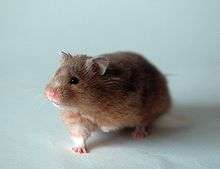
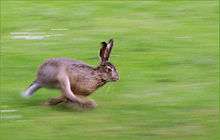
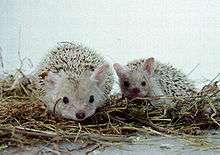

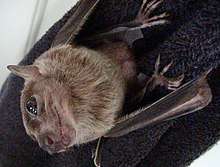


.jpg)
